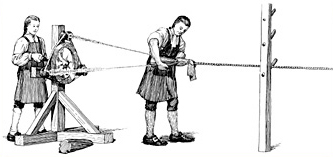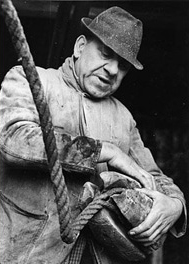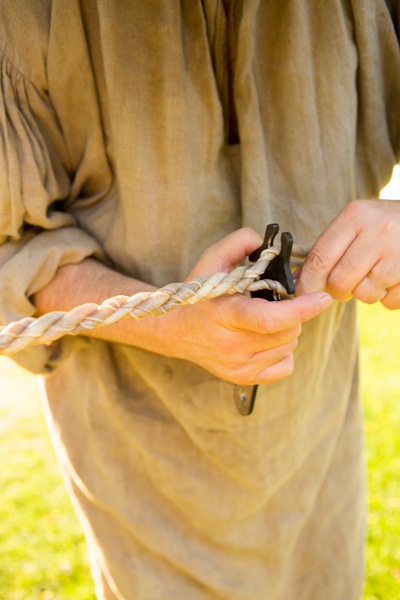all hands were employed in making Oars, and Ropes,
the latter were made out of bear Skins,
we made this day 20 Oars & 600 feet of Rope,
the place we called Rope walk Camp.
Twisting Rope
From Edwin Tunis, The Young United States, 1783 to 1830 (New York: World Publishing Co., 1969), 82. Used by permission of the estate of Edwin Tunis.
One man cranks the spinner, taking pains to keep his speed steady, while the one holding the “top” walks backwards as the rope is twisted.
Certain things they had to take along because they depended on them, and they couldn’t manufacture them on the run. Guns, powder and lead, and the blacksmiths’ tools. Paper and ink. Medicines—except for the herbal and ethnobotanical remedies Lewis knew of, or that Sacagawea and other Indians introduced them to.
There was another item that was critical, too, but that one they could manufacture themselves, and often did—rope. Rope for handling the barge (called the ‘boat’ or ‘barge’ but never the ‘keelboat’), the pirogues and the canoes. Rope to secure sails and anchors, and for towing—”the safest and most expiditious mode of traveling,” Lewis once remarked. Rope for fastening packages, assembling tents, and controlling horses. In a purely physical sense, the expedition was held together by rope. Yet the word is nowhere to be found in Lewis’s preliminary supply-list, nor among his receipts for purchases. Rope was so much a part of life then that its everyday utility was taken for granted.
Only three simple tools are required to make a rope: a twisting or spinning device, a “sledge” to anchor the opposite end, and a grooved wedge called a “top” that is inserted among the strands and drawn ahead of the twist to keep it smooth and tight. The strands must be twisted evenly, without kinking, and all strands must be under equal tension until the whole process is finished for one fathom of rope. Finally, the ends of the rope must be whipped off with crown-and-back-splices to keep them from unraveling.
Although the journals contain no evidence that the expedition’s baggage included the tools for a ropewalk, it is certain that those much-need ropes, although not always dependable, could not have been made without them.
Hemp Rope
In America, until the 1830s when manilla fiber began to be imported from the Phillipines, the best rope was made of domestic hemp. Piles of fibers were spun into threads or yarns; many yarns were twisted into a strand; three or more strands were twisted together to form a rope. Typically, rope was made in 100-fathom lengths (600 feet), and the twisting had to be done in a straight line with the strands fully extended together, because a firm and steady tension had to be applied until the whole length was done. For practical purposes the rope walk had to be sheltered indoors, so the term ropewalk came to denote both the process and the place. Ropewalk buildings up to 1,000 feet long were the most distinctive structures in any town.
Elk Hide Rope
Braiding an Elk Hide Rope
Historical interpretation by John W. Fisher and the Pacific Northwest Living Historians. Photo © 2016 by Kristopher K. Townsend. Permission to use granted under the Creative Commons Attribution-Share Alike 4.0 International license.
It was rope that governed the progress of the expedition’s progress almost from the beginning. The Corps set out early on the morning of 17 June 1804, but came to after only one mile and spent the rest of the day making oars and repairing “Cable & toe tope &c. &c. which was necessary for the Boat & Perogues.” Clark “Set Some men to make a Toe Rope out of the Cords of a Cable which had been provided by Capt Lewis at Pitts burg for the Cable of the boat.” In frontier settlements and garrisons it was often necessary to use strips of animals skins in place of hemp strands, so it was no novelty for the Corps to resort to bearskin on that day. Ten days after leaving that “Rope walk Camp” they stopped again to make rope, this time of elk skin. On 29 August 1804, they paused again to make rope out of green—that is, not yet dried—elk hides. On 23-24 November 1804 they set up another “Rope works” and made a thick hawser of nine strands of elk skin to draw the barge onto the riverbank with a windlass.
On 1 March 1805 they began making more rope in preparation for their imminent departure. By the time they reached the White Cliffs of the Missouri, all their tow ropes but one were made of elkskin, which had serious disadvantages. Especially when wet, they would “Stretch and Sometimes brake which indanger the Perogues or Canoe” by placing them at the mercy of the current. The Corps’ one remaining hemp rope was reserved for the white perogue, and it also eventually parted, with a near-disastrous result. During their short stay at the mouth of the Marias River they made a replacement. Descending the Clearwater, Snake and Columbia Rivers they eased their canoes through numerous rapids with elkskin ropes, which sometimes stretched to the breaking point, adding risk to the procedure.
References
Edwin Tunis, The Young United States, 1783 to 1830 (New York: World Publishing Co., 1969), 82.
Mystic Seaport: the Museum of America and the Sea, Plymouth Cordage Company Ropewalk. http://www.mysticseaport.org/locations/village/ropewalk/ (accessed July 2015). The Plymouth Cordage Company Ropewalk, established in 1824, occupied a building 1,000 feet in length; it operated until 1947.
Revolutionary Players, http://www.revolutionaryplayers.org.uk/ (accessed 12 June 2004).



